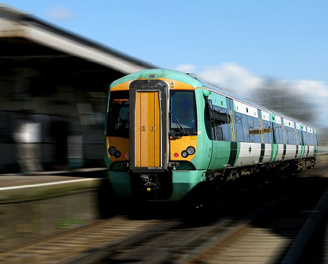This growth has been fuelled by substantial improvements in services provided by the private Train Operating Companies (TOCs) including much more comfortable trains, many more train services and crucially, a far more reliable service than in the past. In fact 20 years ago the major problem for passengers was unreliability. Nowadays the problem is one of rising fares.
The demand for commuter services means that many trains taking passengers in and out of major cities are packed at peak times. The journey from home to the station is also becoming more of a challenge for many commuters as demand for car parking spaces at stations soars and drivers arrive earlier and earlier to get in a space. Many local authorities are also clamping down on parking in streets around stations by introducing pay-for, residents only or limited hours parking.
Ways to encourage train use for commuting and business travel:
-
Catching the bus to the station. Check to see if the station is on the PLUSBUS network. PLUSBUS offers integrated bus and train tickets which could be particularly good value if commuters have to pay for parking at the station.
-
Free lockers and cycling parking. Many railway stations now have free lockers or other undercover cycling parking provision. Check Scotrail for car parking, cycling and other facilities at stations across the Scotrail network.
-
Taking the bike on the train. Many more people now take their bikes with them on the train. This might not be a very practical option if the services are very busy, however it is a solution that could during work off-peak times.
-
Fold-up bikes. Consider purchasing a fold-up bike. These can be taken on-board trains and commuters are not reliant on finding an empty bike storage space.
-
Flexible hours. Employers can help staff that want to travel by train by allowing them to work flexibly. Many return journey train fares are much cheaper after the morning peak has finished at around 9.30am.
-
Offering season ticket loans. In addition, under UK tax laws, employers can help staff by providing interest free loans of up to £5000 for season tickets.
Business Travel by Train:
-
Wi -Fi access. Many trains have Wi-Fi which makes on-board working more achievable.
-
Consider First Class Vs Second Class travel. Consider carefully your organisation’s policy on First and Standard Class travel. Whilst First Class might be pricey it can often provide more productive working time than sitting (or standing!) in Standard Class.
-
Avoid travelling on Fridays. Encourage employees to avoid travelling on Fridays, especially on longer distance services. This tends to be the busiest day on the railways and it can be difficult to work.
-
Book tickets in advance. The golden rule for business travel is to try and book tickets as far in advance as possible. Avoid getting train tickets on the day as these are almost always the most expensive option.
-
Investigate splitting ticket purchases. If there are particular destinations the employees in your organisation regularly travel to, look at the fares if the ticket was to be split part way, as they often work out cheaper. For example if staff regularly travel from Glasgow to Birmingham look at the price for Glasgow to Preston and Preston to Birmingham as it might work out cheaper. Provided the person travels through Preston, breaking the tickets is not an issue, even if they stay on the same train. The downside is that they may have to change reserved seats on the way.
-
Taxis. To find phone numbers of taxi companies operating at different railway stations see Traintaxi.
